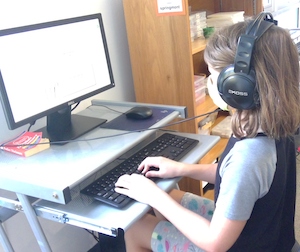News
News
Ask a Division Head: Is cursive handwriting still relevant in the age of technology?

Cursive to Keyboards – Elementary Children and the Written Word
Cursive handwriting has long been a hallmark of Montessori education but is it still relevant in the age of technology? Developmentally speaking, the process of writing builds eye-hand coordination and control of movement and engages areas of both cerebral hemispheres. In fact, studies of older students show that notes taken by hand are processed more deeply and are more likely to transfer to long term memory than notes transcribed using a keyboard.
But why cursive first? The movements of cursive handwriting are natural for young children’s hands whose first drawings mirror the loops and curved lines of cursive instead of the “sticks and balls” of print. Practically speaking, cursive handwriting eliminates having to make decisions about when to lift the pencil tip and ponder where to put it back down to continue forming the letter. In writing the alphabet from A to Z in print, one researcher found that a child would have to remove the pencil from the paper and relocate the starting point no less than 55 times, leaving lots of room for error in letter formation. Additionally, print writing often results in letter reversals (think b/d, p/q and f/t) while the formation of cursive letters makes this, as well as false capitalizations, much less common for developing writers.
Is there room for keyboarding in a Montessori classroom? Of course! Developing keyboarding skills, particularly proper hand placement and learning to touch type (typing without looking at the keys), is also important. Springmont utilizes the Keyboarding Without Tears program with Elementary-aged students to build and practice these skills over time. However, keyboarding should not take the place of developing the fine motor skills fundamental to writing during the Elementary years. Firm development of cursive handwriting supplemented by good keyboarding skills gives children the cognitive, physical, and practical skills necessary to be fluent writers in a variety of ways.


3 weeks ago
4 weeks ago